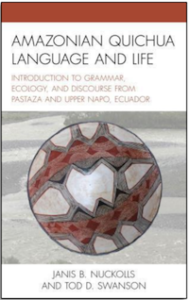
AMAZONIAN QUICHUA LANGUAGE & LIFE by J.B. Nuckolls & T.D. Swanson (2020)
 Amazonian Quichua Language and Life
Amazonian Quichua Language and Life
Introduction to Grammar, Ecology, and Discourse from Pastaza and Upper Napo,Ecuador
By Janis B. Nuckolls and Tod D. Swanson
Lexington Books, 2020
In Amazonian Quichua Language and Life: Introduction to Grammar, Ecology, and Discourse from Pastaza and Upper Napo, Ecuador, Janis B. Nuckolls and Tod D. Swanson discuss two varieties of Quichua, an indigenous Ecuadorian
language. Drawing on their linguistic and anthropological knowledge, extensive fieldwork, and personal relationships
with generations of speakers from Pastaza and Napo communities, the authors open a door into worlds of intimate
meaning that knowledge of Quichua makes accessible. Nuckolls and Swanson link grammatical lessons with
examples of naturally occurring discourse, traditional narratives, conversations, songs, and personal experiences to
teach readers about the languages’ structures and discourse patterns and speakers’ sensory depictions, ecological
aesthetics, and emotional perspectives.
Special 30% Discount Offer! To get discount, use code LEX30AUTH20 when ordering (may not be combined with other offers and discounts, valid until 10/14/2021.)
TO ORDER WORLDWIDE: https://Rowman.com/Lexington
[expand title=”Amazonian Quichua Language and Life – Table of Contents” tag=”h2″]
Introduction
Part 1: Self and Other
- Lesson 1: The most basic verbal interactions
- Lesson 2: Expressing ideas of being
- Lesson 3: Talking about family
- Lesson 4: Types of questions
- Lesson 5: Affirming, negating and evading
- Lesson 6: Articulating the perspectives of self and other
- Lesson 7: Human and nonhuman bodies
- Lesson 8: Expressing thoughts, feelings, processes, and enumeration
- Lesson 9: Suffixes of instrumentality, accompaniment and the imperatives
- Lesson 10: Suffixes of Togetherness, Separateness, and Exclusivity
Part 2: Space and Time
- Lesson 11: Purpose, directionality, duration, color
- Lesson 12: Attribution, location, past tense
- Lesson 13: Habituality, complex movement suffixes, delimitation
- Lesson 14: The Co-reference suffix –sha
- Lesson 15: The Switch-Reference suffix –kpi
- Lesson 16: The Present Perfect –shka
- Lesson 17: Talking about the future
- Lesson 18: Varieties of compound verbs
- Lesson 19: Conditionality, ordering and connecting ideas
- Lesson 20: Evidentiality, speech reports, Inchoative –ya, and Purposive –chun
Vocabulary
Bibliography
[/expand]
About the authors
Janis Nuckolls is professor of anthropological linguistics at Brigham Young University.
Tod D. Swanson is associate professor in the faculty of religious studies at Arizona State University.

